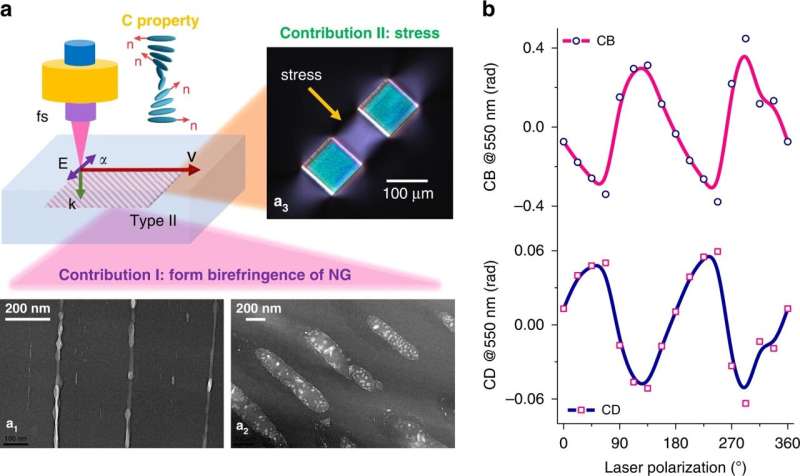This article has been reviewed according to Science X's editorial process and policies. Editors have highlighted the following attributes while ensuring the content's credibility:
fact-checked
peer-reviewed publication
trusted source
proofread
Writing on glass and silica indicates novel direction for chiral optical property tailoring

From fundamental physics of light-matter interaction to fabrication of targeted optical properties in highly complex optical engineering, the femtosecond (fs) laser plays a crucial role in laser manufacturing. Ultrashort light pulses can precisely deposit light energy in a given transparent material volume by controllable focusing conditions. Nonlinear absorption of high-density photon energy leads to the creation of free electrons plasma within a few fs, before the electron-phonon energy transfer to the lattice.
At a low repetition rate, the glass network heating is decoupled from light exposure and the plasma itself, enabling localized modifications or even breakdown without surrounding damage. Such nonlinear processes contribute to multiple types of modifications according to laser parameters. The fs laser-induced modifications have found many applications in most branches of nonlinear science, ranging from plasma physics and nano-photonics to material science, bio-photonics and quantum information science.
In a new paper published in Light: Science & Applications, a team of scientists led by Professor Matthieu Lancry from the University Paris Saclay has developed a new technique to tailor chiral optical properties. Their novel procedure implements fs laser 3D direct writing on glasses.
Recent progress highlights that an fs laser beam (axially symmetric intensity distribution, linearly polarized with orthogonal incidence) can create optical chirality inside an achiral material through a direct laser writing. This concept shed light on a new approach for tailoring chiral optical properties in 3D, providing a wider landscape of laser manufacturing. A prerequisite to exploiting such new potentials is to elucidate of how one can manipulate these chiral optical properties.
In this work, they suggested that the breaking of symmetry arises from the combined action of a stress field and a form birefringence due to nanograting formation with the non-parallel non-orthogonal neutral axis. This extrinsic chiral assembly is the source of the observed optical chirality, namely optical rotation and circular dichroism.
The researchers attempted to "disassemble" the dependence of the form birefringence and stress contributions concerning the laser polarization direction. In a simple view, the slow/fast axis of the form birefringence is controlled by the laser polarization direction and the related amplitude by the laser fluence.
Whereas the orientation of stress-induced birefringence is mostly dictated by the scanning geometry. A two-layer model is then developed based on Mueller formalism. It quantitatively explains the creation of both linear and circular anisotropic optical properties.
Finally, the researchers exploited their model to engineer chiral optical properties following two different designs: multilayer "nanograting-based waveplates" and an ultralow loss design based on "stress-engineered waveplates." The results provide clear evidence that the origin of fs laser-induced circular properties includes two contributions and propose a strategy for tailoring chiral optical properties in any glasses by fs laser direct writing.
More information: Jiafeng Lu et al, Tailoring chiral optical properties by femtosecond laser direct writing in silica, Light: Science & Applications (2023). DOI: 10.1038/s41377-023-01080-y
Journal information: Light: Science & Applications
Provided by Chinese Academy of Sciences





















